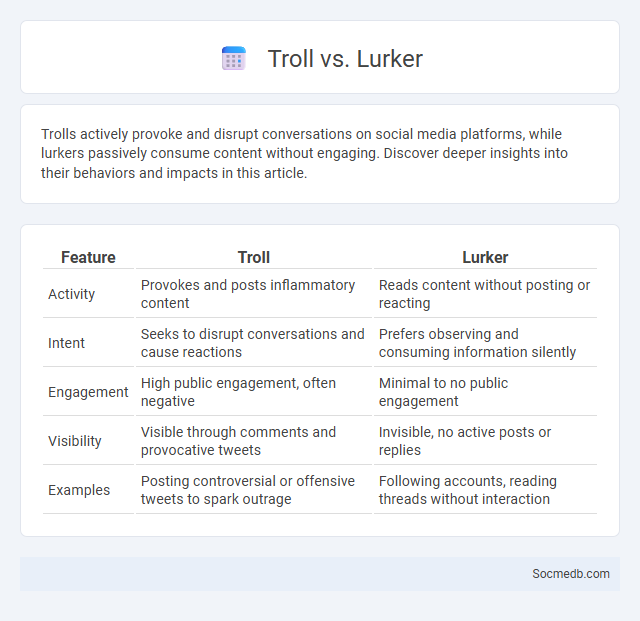
Photo illustration: Troll vs Lurker
Trolls actively provoke and disrupt conversations on social media platforms, while lurkers passively consume content without engaging. Discover deeper insights into their behaviors and impacts in this article.
Table of Comparison
| Feature | Troll | Lurker |
|---|---|---|
| Activity | Provokes and posts inflammatory content | Reads content without posting or reacting |
| Intent | Seeks to disrupt conversations and cause reactions | Prefers observing and consuming information silently |
| Engagement | High public engagement, often negative | Minimal to no public engagement |
| Visibility | Visible through comments and provocative tweets | Invisible, no active posts or replies |
| Examples | Posting controversial or offensive tweets to spark outrage | Following accounts, reading threads without interaction |
Introduction to Internet Personas
Internet personas shape how you present yourself on social media platforms, influencing your interactions and digital footprint. Crafting a consistent persona enhances personal branding and can increase engagement across networks like Instagram, Twitter, and LinkedIn. Understanding the impact of your online identity helps manage privacy and builds trust with your audience.
Defining Trolls: Characteristics and Behaviors
Trolls on social media platforms exhibit disruptive behaviors characterized by deliberately provocative, inflammatory, or off-topic comments aimed at eliciting emotional responses or derailing conversations. These users often employ anonymity or pseudonyms to avoid accountability while spreading misinformation, harassment, or hate speech. Recognizing patterns such as persistent antagonism, lack of constructive dialogue, and targeting specific individuals or groups helps in identifying troll activity across networks like Twitter, Facebook, and Reddit.
Understanding Lurkers: Silent Observers Explained
Lurkers on social media platforms are users who consume content without engaging through likes, comments, or shares, representing a significant portion of the online audience. Understanding lurkers is crucial for marketers and content creators aiming to tailor strategies that convert passive viewers into active participants. Data indicates that lurkers often seek information and entertainment, influencing trends and community sentiment despite their silent presence.
Troll Origins: How and Why They Emerge
Troll origins trace back to the early internet culture, where anonymous users deliberately provoked others for amusement or disruption. Social media platforms amplify trolling behavior by providing widespread reach and relative anonymity, making it easier for trolls to influence discussions or spread misinformation. Understanding these dynamics helps you recognize and mitigate the impact of trolls on your online experience.
Lurker Motivations: Reasons for Staying Silent
Lurker motivations in social media often include the desire to gather information without engaging publicly, fear of negative judgment, or lack of confidence in expressing opinions. You may stay silent to avoid conflict, maintain privacy, or simply because passive observation meets your needs better than active participation. Understanding these reasons helps platforms design features that encourage more meaningful interaction and user comfort.
Troll Impact: Effects on Online Communities
Trolls significantly disrupt online communities by spreading negativity, inciting conflicts, and diminishing the quality of discussions, which impacts user engagement and trust. Your online experience can be adversely affected as trolls provoke emotional responses, making it difficult to maintain constructive conversations. Combatting troll impact requires active moderation and community guidelines to preserve a positive and inclusive digital environment.
Lurker Roles: Positive and Negative Contributions
Lurker roles on social media contribute positively by absorbing and reflecting community norms without posting, which helps maintain group cohesion and reduces content noise. These passive participants also negatively impact platforms by limiting active engagement and feedback, potentially stalling discussion growth and innovation. Understanding your role as a lurker can help balance silent observation with meaningful interaction to enhance community dynamics.
Troll vs. Lurker: Key Differences Compared
Trolls actively seek to provoke and disrupt online conversations by posting inflammatory or offensive content, while lurkers passively consume social media without engaging or contributing. Your ability to distinguish between trolls and lurkers is crucial for maintaining a positive digital environment and managing online interactions effectively. Trolls often aim to incite emotional reactions, whereas lurkers typically observe quietly, gathering information without participation.
Troll vs. Troll: Types and Strategies
Troll vs. Troll interactions on social media often involve distinct types such as aggressive provocateurs who use insults and misinformation, and strategic manipulators who exploit sensitive topics to incite conflict. Your best strategy involves recognizing these trolls by their patterns--repetitive inflammatory comments, identity deception, or coordinated group attacks--and responding with patience or ignoring to avoid escalation. Understanding the motivations behind troll behavior enables you to develop effective countermeasures, including reporting abuse and deploying platform tools designed to reduce toxic engagement.
Managing Trolls and Lurkers: Best Practices
Managing trolls and lurkers in social media requires implementing strict community guidelines that clearly define acceptable behavior and consequences for violations. Utilizing advanced moderation tools such as AI-powered content filters and real-time monitoring helps detect and address negative interactions swiftly. Encouraging positive engagement through transparent communication and rewarding constructive participation reduces the impact of disruptive users and fosters a healthier online environment.
 socmedb.com
socmedb.com